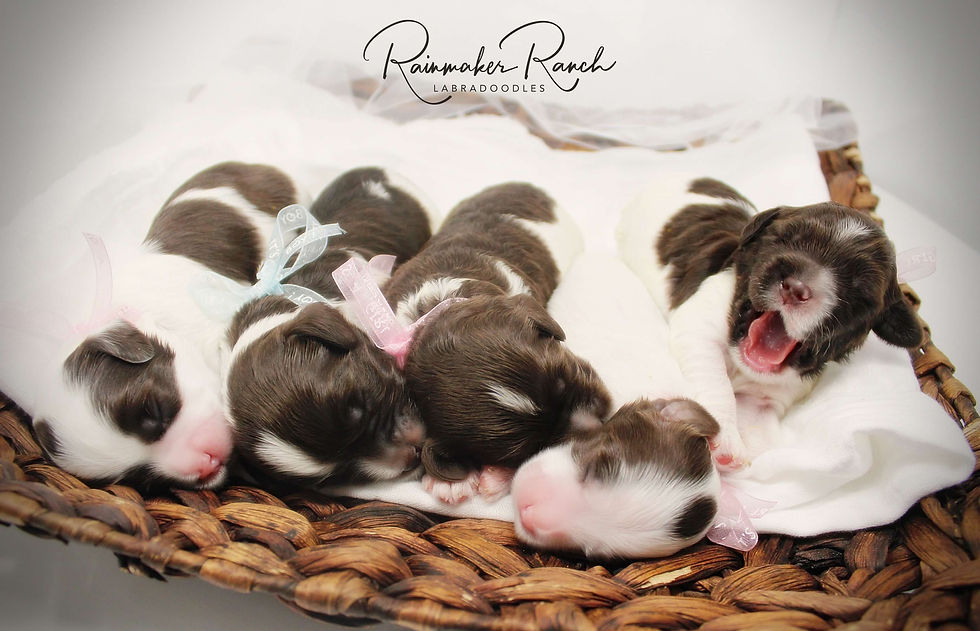top of page

Health & Genetics in Labradoodles
Our Goal :
To bring families exceptional Labradoodles—exceptional in health, temperament, and conformation.
Do Labradoodles Have Health Problems?
Yes—all dogs, including Labradoodles, can be prone to health issues. While some believe that crossing breeds inherently produces healthier dogs, the reality is more nuanced.
Poodles, Labrador Retrievers, and Cocker Spaniels (both English and American)—the foundational breeds behind Labradoodles and Australian Labradoodles—each have their own potential genetic concerns. These include:
-
Hip and elbow dysplasia
-
Eye conditions
-
Heart disease
-
Von Willebrand's disease
-
Addison’s disease
-
Cancer
-
Thyroid disorders
-
Skin disorders such as Sebaceous Adenitis (SA)
How We Ensure Healthier Puppies
At Rainmaker Ranch, we are committed to producing the healthiest puppies possible. This begins with the careful selection of our breeding dogs and extends to comprehensive health testing of every generation in your puppy’s pedigree.
We complete:
-
OFA or PennHIP screening for hip and elbow dysplasia
-
Annual CERF/ACVO eye exams
-
Cardiac screening
-
Full Paw Print Genetics DNA panels
-
Thyroid panels and CBC blood work
You will receive:
-
A vet-certified health report and vaccination record at pickup
-
A three-year health guarantee for hips, and a two-year guarantee for elbows, patella, and Von Willebrand’s Disease
What Is “Hybrid Vigor” (Heterosis)?
“Hybrid vigor,” or heterosis, refers to increased strength and health in offspring from genetically diverse parents. While the term is often used to promote designer breeds like Labradoodles, it’s important to understand the limitations.
Important distinctions:
-
True hybrids are crosses between species (e.g., horse + donkey = mule).
-
Labradoodles are a cross between two breeds of the same species (dogs), so the term “hybrid” is not scientifically accurate.
-
Heterosis can provide temporary benefits, such as masking recessive genetic diseases—but only in the first-generation cross.
Once Labradoodles are bred to other Labradoodles or Poodles, those benefits are reduced or lost. One condition where first-generation crosses have shown clear benefit is Sebaceous Adenitis (SA), as it’s more prevalent in Poodles and not in Labs. However, issues like hip dysplasia and Addison’s exist in both breeds and can still appear in mixed offspring.
Why Health Testing Matters
It’s a myth that crossbreeding alone eliminates health risks. Without thorough testing, crossbreeds can inherit more issues, not fewer. Responsible breeders invest $1,000–$1,500 per dog to perform the necessary tests.
This ensures:
-
You receive a puppy with the best possible chance for a healthy, long life
-
Genetic diseases are identified and bred out over generations
-
Puppies are not just adorable, but sound in both body and temperament
The Importance of Temperament
Temperament is just as important as health. Poor breeding practices—especially prioritizing appearance or size over behavior—can lead to unstable or unpredictable temperaments.
At Rainmaker Ranch, we prioritize:
-
Temperament-tested parents and lines
-
Multi-generational selection for gentle, intelligent, family-friendly behavior
When outcrossing is done thoughtfully and with temperament as the guiding principle, it can help reintroduce diversity and improve behavior in the resulting offspring.
How Long Do Labradoodles Live?
Labradoodles typically live 12–16 years. With excellent nutrition, responsible vaccine protocols (such as titer testing), minimal chemical exposure, and a healthy genetic background, they can live even longer.
We’ve been breeding since 2002, and many of our early litters are still thriving today.
Final Thoughts
We encourage you to educate yourself about canine health and genetics. One of the most valuable resources we recommend is Control of Canine Genetic Diseases by George A. Padgett, DVM.
Please don’t support breeders who skip health testing or breed irresponsibly. The health and happiness of your future Labradoodle depends on these crucial early decisions.
bottom of page
